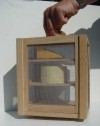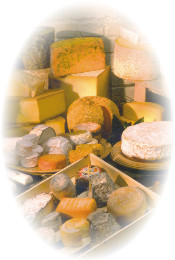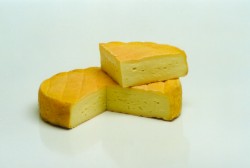 Issue No. 20 - March 2004 |
 |
|||||||||
|
Back Issues: Issue 19 If you came direct to the Cheesewire and want to visit our main site, click here |
In each issue we will cover a wide range of cheese issues and include regular features on: Cheese focus: We take a close look at a different cheese each issue exploring its history, the production methods used and the people involved. Farm focus: Making a quality cheese starts with choosing the right animals and growing the right grass on which they graze. We examine the animals and the farming practices essential for the production of the finest cheeses. Tools of the trade: Cheese has been made for thousands of years and the methods and tools which have evolved are fascinating. Products: New products, services and gift ideas at the Teddington Cheese. This month Cheese and Stilton box set and Olive Spoons. Cheese tips: Tips on selecting, storing and serving cheese.
|
|||||||||
|
Up until Easter 2004 any order accepted will be put in a hat to win 6 bottles of wine (value £50). All you have to do is quote the word "Teddington Wines" with your order. |
||||||||||
|
- Cheese Tips
- The question we are most often asked is, "Where is the best place to store cheese?" Here are some tips in response to this: All cheeses prefer a damp and cool environment. However, if it is too cold the cheese loses its flavour and its development suffers. If it is too warm the cheese sweats, quickly grows mouldy and may over-ripen. If it is too damp the cheese will quickly grow mouldy and if it is too dry the cheese will dry and crack. Favourable places for storing cheese are listed below: 1. Cellar or larder: These are the best places but, unfortunately, few houses are blessed with them. 2. Shed or garage: Generally good places but they are susceptible to weather changes. They may become too hot in the summer and too cold in the winter. 3. Refrigerator: In the majority of centrally-heated houses the refrigerator is simply the safest place to keep cheese. Use the warmest part of the fridge - this is the top shelf unless there is an old-fashioned ice box at the top, in which case the salad drawer at the bottom is best. Wherever you keep your cheese ensure that it remains wrapped in the waxed paper in which we sell it. If storing in a cellar, shed or garage then cover the cheese in a damp tea-towel and place inside a vermin-proof box. Only use cling film if a refrigerator is being used. Always allow cheese to stand at room temperature for a couple of hours before enjoying
|
||||||||||
|
We know have an excellent range of cheese knives (single, stilton scoop, soft cheese and hard cheese knife and a new 'Olive Spoon'. Each of these knives comes in 4 different designs. Just in for a trial period (no photos yet) are the Cheese and Stilton box sets for £17.95 - hurry only two of each design available. We also haveround 'Cheese Boards' available in two styles of handles. To see our range click here. |
||||||||||
|
|
|||||||||
|
|
|||||||||
| All articles © www.teddingtoncheese.co.uk | ||||||||||


